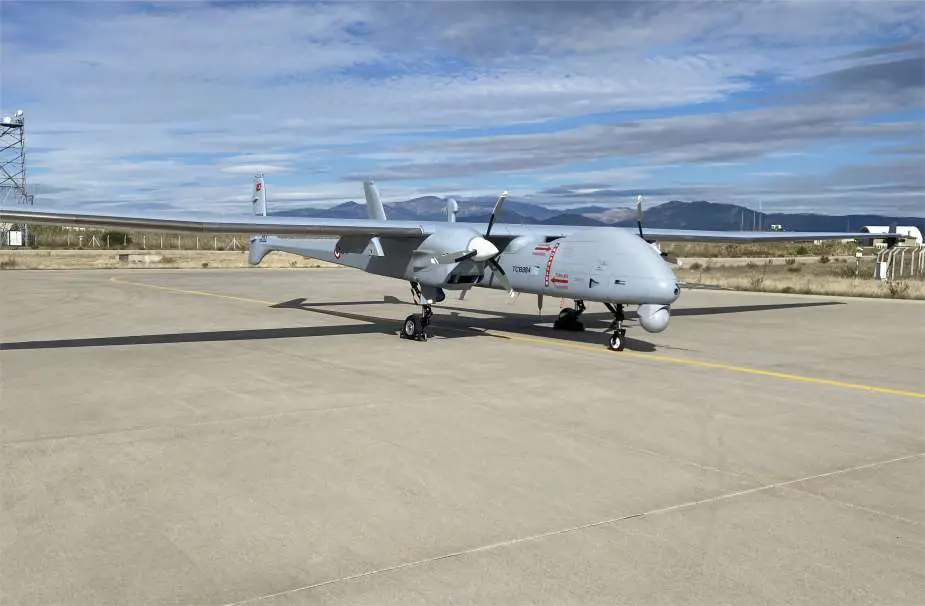Breaking news
Turkish Navy adopts TAI Aksungur UAV as newest surveillance asset.
On December 16, 2023, the Turkish Ministry of Defense announced that the Aksungur Unmanned Aerial Vehicle (UAV) with tail number TCB-884 had been integrated into the Naval Forces Command. This significant development occurred during a ceremony at the Dalaman Naval Air Base Command on December 15, 2023, marking the successful completion of the Operative UAV Project by Turkish Aerospace Industries (TAI), with this UAV being the final unit produced.
Follow Navy Recognition on Google News at this link
 The Aksungur UAV has a maximum service ceiling of 40,000 feet, an endurance of 50 hours, and a payload capacity exceeding 750 kg. (Picture source: Turkish MoD)
The Aksungur UAV has a maximum service ceiling of 40,000 feet, an endurance of 50 hours, and a payload capacity exceeding 750 kg. (Picture source: Turkish MoD)
The inclusion of this UAV in the Turkish Naval Forces' arsenal is part of Türkiye's ongoing initiative to update its Armed Forces with locally developed military equipment. This step also signifies an increase in the Naval Forces' surveillance and reconnaissance capabilities, aligning with their operational requirements.
Showcased at the Paris Air Show 2023, the Aksungur UAV belongs to the Medium Altitude Long Endurance (MALE) class of Unmanned Aerial Vehicles (UAVs) and is designed for a range of missions, including Intelligence, Surveillance, and Reconnaissance (ISR), ground attack, and maritime patrol. Manufactured by Turkish Aerospace, this MALE UAV has dimensions of 11.6 m in length, a wingspan of 24 m, and a height of 3.1 m. The Aksungur can reach a maximum service ceiling of 40,000 feet, has an endurance of 50 hours, a datalink range exceeding 250 km, and a payload capacity exceeding 750 kg, all while maintaining a maximum takeoff weight of 3,300 kg.
The use of two PD-170 twin-turbocharged diesel engines, each producing 170 hp, provides several advantages for the Aksungur MALE UAV. Firstly, the dual-engine design allows the UAV to continue operating even if one engine fails, offering an additional layer of operational security for long-duration missions, particularly in areas where engine failure could pose significant risks. This configuration also has the potential to extend the UAV's range and endurance due to the increased power.
The dual-engine setup broadens the range of possible mission profiles, enabling the Aksungur to adapt to a variety of tasks. These tasks include image intelligence, surveillance and reconnaissance, maritime patrols, tactical strikes via ground attacks, and communication missions. Furthermore, two engines can enhance the UAV's overall performance, potentially allowing for increased speed capabilities, improved climb rates, and the ability to carry more substantial payloads.
In terms of payload options, the Aksungur UAV is equipped to handle various equipment such as sensors, cameras, or armaments. Image Intelligence payloads include EO/IR/LD/LRF cameras, SAR/GMTI-ISAR, and Wide Area Surveillance Cameras. For maritime patrols, it is equipped with SAR/GMTI-ISAR, an Automatic Identification System (AIS), a Sonobuoy Pod, and a Magnetic Anomaly Detector (MAD) Boom.
The communication payloads consist of SATCOM, Personnel Locating System (PLS), V/UHF Radio Relay, and an Airborne Communications Node Pod. Additionally, it can carry various air-to-ground weapons and precision guidance kits, including TEBER-81, TEBER-82, L-UMTAS, MAM-L, Cirit, HGK-3, KGK (82), and Small Diameter Bomb (SDB), utilizing its six hardpoints.
The Aksungur UAV is designed for autonomous operation, featuring redundant systems for automatic takeoff and landing, electrical power generation, and secure digital datalinks. It complies with DO-178B software and DO-254 hardware standards and is compatible with Ground Control Systems (GCS) and datalink systems used by existing ANKA UAV systems. Optional features, such as an ice protection system and Beyond Line of Sight (BLOS) operation with SATCOM, further enhance its operational capabilities.























